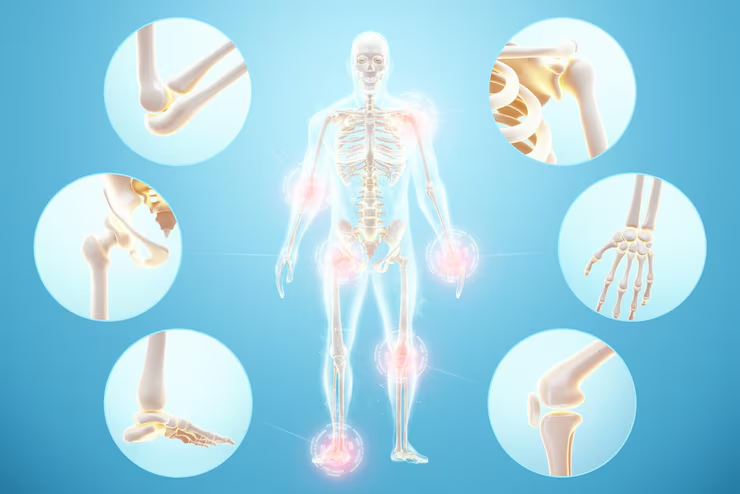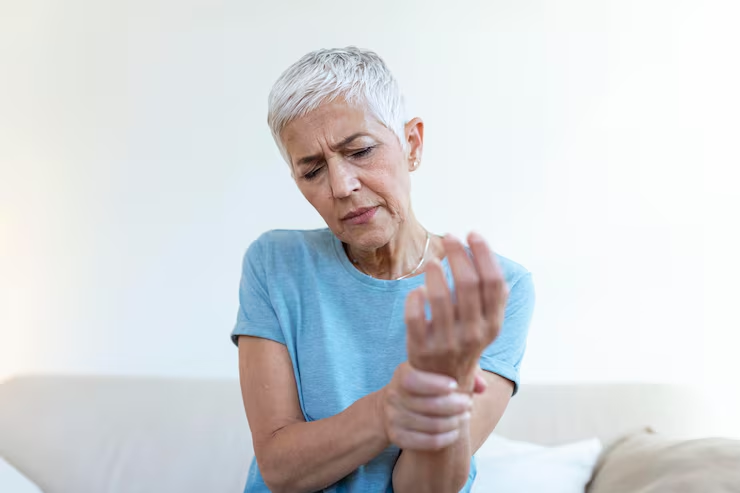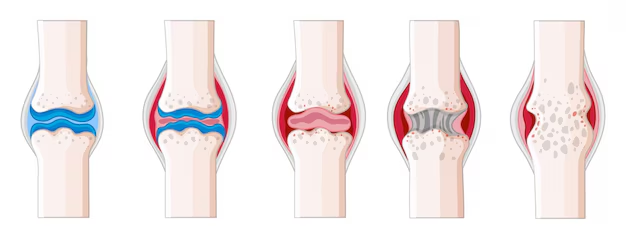Bone and joint health plays a critical role in maintaining our body’s structure and mobility. Bones provide the strength and shape needed to support our body, while joints offer the flexibility to move freely. Together, they form the foundation that allows us to perform daily tasks such as walking, lifting, and bending.
As we grow older, our risk of developing conditions like osteoporosis, arthritis, and joint pain increases. Weak bones and stiff joints can lead to reduced mobility and a higher chance of fractures. Lifestyle choices, including poor nutrition, inactivity, and smoking, can further harm bone and joint health over time. Early prevention and awareness are key to avoiding long-term complications.
To support lifelong strength and mobility, it’s essential to follow a balanced diet that includes nutrients like calcium and vitamin D, engage in regular weight-bearing activities, and keep your body weight within a healthy range. These daily habits promote better posture, reduce the risk of injuries, and enhance physical performance over time.

Caring for your body’s structural system isn’t just something to think about later in life. Starting early and staying consistent can greatly improve your overall well-being, reduce the chance of chronic pain, and help you stay active, independent, and confident as you age.
In this ultimate guide, we’ll cover:
The structure and role of bones and joints
Common issues affecting skeletal health
Nutrition, exercise, and lifestyle recommendations
Top 8 expert tips to keep your bones and joints strong for life
Understanding the Basics : Bones and Joints
Bones and joints are essential parts of the human body, forming the structural system that supports and enables movement. Bones provide the shape, strength, and protection for vital organs, while joints connect bones and allow for flexibility and motion. Together, they make daily activities like walking, running, and lifting possible.
Maintaining proper bone and joint health is important at every stage of life. As we age, our bones may lose density and joints can wear down, increasing the risk of conditions like arthritis and osteoporosis. Poor posture, lack of physical activity, and an unhealthy diet can also contribute to joint stiffness and weak bones.
To promote lifelong bone and joint health, it’s crucial to follow a healthy lifestyle. Eating calcium- and vitamin D-rich foods, engaging in regular exercise, and avoiding harmful habits like smoking can help maintain strength and mobility. Caring for your bones and joints today leads to better health tomorrow.
What Are Bones?
Bones are living tissues made of collagen (a protein that provides soft framework) and calcium phosphate (a mineral that adds strength). The human body has 206 bones that serve several crucial functions:
Structural support
Movement
Protection of internal organs
Production of blood cells (in the bone marrow)
Mineral storage (mainly calcium and phosphorus)
What Are Joints?
Joints are the connections between bones that allow movement. There are several types of joints:
Hinge joints (like knees and elbows)
Ball-and-socket joints (like shoulders and hips)
Pivot joints (like neck vertebrae)
Gliding joints (like wrists)
Healthy joints contain cartilage to cushion the bones, synovial fluid to lubricate them, and ligaments and tendons for support.
Common Bone and Joint Disorders
Bone and joint health is vital for maintaining mobility, strength, and overall well-being. However, several disorders can affect the skeletal system, leading to discomfort, limited movement, or long-term damage. Understanding these conditions is the first step toward prevention and proper management.
Common bone and joint disorders include osteoporosis, where bones become weak and brittle, and arthritis, which causes joint pain and stiffness. Osteoarthritis, the most common form, occurs when cartilage wears down over time, while rheumatoid arthritis is an autoimmune condition that inflames joints. Other issues like fractures, gout, and bursitis also impact bone and joint health and can affect people of all ages.
Promoting bone and joint health through early diagnosis, proper treatment, and preventive care is essential. Regular exercise, a nutrient-rich diet, and medical check-ups can help reduce the risk of these disorders and maintain strong, healthy bones and joints throughout life.
Osteoporosis – A condition where bones become weak and brittle due to calcium deficiency.
Arthritis – Inflammation of joints that causes pain and stiffness.
Osteoarthritis: Wear and tear of cartilage.
Rheumatoid arthritis: An autoimmune disease attacking joints.
Osteopenia – Early stage of bone loss, often a precursor to osteoporosis.
Fractures and Injuries – Caused by trauma, accidents, or weakened bones.
Joint Dislocation and Sprains – Usually from sudden movements or sports injuries.
Gout – A type of arthritis caused by uric acid crystals in the joints.
Causes of Poor Bone and Joint Health

Bone and joint health can decline due to a combination of lifestyle, medical, and environmental factors. One major cause is poor nutrition—diets low in calcium, vitamin D, and other essential nutrients can weaken bones and damage joint tissues. Without proper nutrients, the body struggles to maintain strong bones and flexible joints.
A sedentary lifestyle also contributes to poor bone and joint health. Lack of physical activity reduces bone density and muscle strength, increasing the risk of osteoporosis and joint stiffness. Additionally, habits like smoking and excessive alcohol consumption can interfere with the body’s ability to absorb calcium and maintain healthy bone tissue.
-Age-related changes, hormonal imbalances, and certain medical conditions like arthritis or thyroid disorders can also negatively affect bone and joint health. Understanding these causes helps individuals take preventive steps, such as exercising regularly, eating well, and avoiding harmful habits, to support long-term strength and mobility.
Lack of physical activity
Nutrient deficiencies (calcium, vitamin D, magnesium, etc.)
Smoking and excessive alcohol use
Hormonal imbalances (especially in post-menopausal women)
Chronic inflammation
Obesity
Aging
Genetics
Top Tips for Bone and Joint Health
Prioritize Calcium and Vitamin D Intake

Maintaining strong bones and joint health starts with proper nutrition. Calcium is essential for building and maintaining bone mass, while vitamin D helps the body absorb calcium effectively. A deficiency in either can lead to weakened bones and increase the risk of conditions like osteoporosis.
To support bone and joint health, include calcium-rich foods like dairy products, leafy greens, and fortified cereals in your diet. Sunlight exposure and foods such as fatty fish and egg yolks provide vitamin D. Supplements may be necessary if dietary intake is insufficient, especially for older adults or those with limited sun exposure.
Why it matters: Calcium builds bones, and vitamin D helps the body absorb it.
Recommended Sources:
Dairy (milk, yogurt, cheese)
Leafy greens (kale, spinach)
Almonds
Sardines and salmon (with bones)
Fortified foods (cereals, plant-based milk)
Sunlight exposure (15–30 minutes/day for vitamin D)
Supplements if dietary sources aren’t enough
Engage in Weight-Bearing and Resistance Exercises
Regular physical activity is essential for maintaining strong bones and joint health. Weight-bearing exercises like walking, jogging, and dancing stimulate bone growth by putting healthy stress on the skeleton. Resistance training, such as lifting weights or using resistance bands, helps build muscle, which supports joints and improves balance.
These exercises not only enhance bone density but also increase joint flexibility and reduce the risk of falls and fractures. To support long-term bone and joint health, aim for at least 30 minutes of moderate activity most days of the week, combined with strength training two to three times weekly.
Why it matters: Exercise stimulates bone-forming cells and strengthens muscles that support joints.
Best Exercises:
Walking or brisk walking
Jogging or running
Weight lifting or resistance training
Yoga and Pilates (for flexibility and balance)
Jump rope and dancing (for bone density)
Maintain a Healthy Body Weight

Maintaining a healthy body weight is crucial for long-term bone and joint health. Excess body weight puts added pressure on weight-bearing joints like the knees, hips, and lower back, increasing the risk of joint pain, osteoarthritis, and mobility issues. Over time, this strain can wear down cartilage and lead to chronic joint damage.
On the other hand, being underweight can also harm bone and joint health by reducing bone density and increasing the risk of fractures. Achieving and maintaining a balanced weight through a nutritious diet and regular exercise helps reduce stress on joints and supports overall skeletal strength.
Why it matters: Excess weight increases pressure on joints, especially hips, knees, and lower back. This accelerates cartilage wear and can lead to osteoarthritis.
How to Achieve It:
Balanced, calorie-controlled diet
Portion control and mindful eating
Regular physical activity
Hydration and adequate sleep
Include Anti-Inflammatory Foods
Eating anti-inflammatory foods can significantly support bone and joint health by reducing swelling and discomfort in the joints. Chronic inflammation is a common cause of joint pain and can worsen conditions like arthritis. Foods rich in omega-3 fatty acids—such as salmon, flaxseeds, and walnuts—help combat inflammation naturally.
Other beneficial options include berries, leafy greens, turmeric, and olive oil, all known for their anti-inflammatory properties. including these into your daily diet not only eases joint stiffness but also supports overall bone strength. A balanced, anti-inflammatory diet is a powerful tool for maintaining long-term bone and joint health.
Why it matters: Chronic inflammation can damage cartilage and lead to joint pain and stiffness.
Top Anti-inflammatory Foods:
Fatty fish (omega-3-rich salmon, mackerel
Turmeric (curcumin is a potent anti-inflammatory)
Olive oil
Berries and citrus fruits
Leafy greens
Green tea
Nuts (walnuts, almonds)

Stay Hydrated for Joint Lubrication
Proper hydration plays a key role in maintaining bone and joint health. Water helps keep the cartilage in your joints soft and lubricated, allowing for smooth and pain-free movement. Dehydration can lead to joint stiffness, discomfort, and reduced flexibility over time.
Drinking enough water each day supports the production of synovial fluid, which cushions and protects the joints during movement. Aim for at least 6–8 glasses of water daily, or more if you’re active or live in a hot climate. Staying hydrated is a simple yet effective way to promote lifelong bone and joint health.
Why it matters: Synovial fluid in joints needs water to keep the joints lubricated and flexible.
Tips:
Drink 8–10 glasses of water daily
Include water-rich foods (cucumbers, watermelon, oranges)
Avoid dehydrating drinks (excess caffeine and alcohol)
Don’t Ignore Posture and Ergonomics
Good posture and proper ergonomics are essential for protecting bone and joint health. Poor posture, especially during long hours of sitting or working at a computer, can strain the spine, shoulders, and joints, leading to pain and long-term damage. Over time, this stress can weaken muscles and misalign joints.
Using ergonomic furniture, adjusting screen height, and practicing proper sitting and standing techniques can help maintain spinal alignment and reduce joint strain. Regularly stretching and taking breaks during sedentary activities further supports bone and joint health, helping prevent discomfort and promoting better posture throughout daily life.
Why it matters: Poor posture stresses joints and can lead to chronic pain in the neck, back, and hips.
Healthy Habits:
Maintain a neutral spine while sitting
Avoid slouching
Use ergonomic furniture
Adjust screens to eye level
Take regular breaks if working at a desk
Get Regular Bone Density and Health Screenings

Routine health screenings are vital for monitoring bone and joint health, especially as you age. Bone density tests can detect early signs of osteoporosis before symptoms appear, allowing for timely intervention. Early diagnosis helps prevent fractures, manage joint pain, and maintain mobility.
Regular check-ups also help track joint function and identify conditions like arthritis or inflammation. Your doctor may recommend screenings based on age, family history, or risk factors. Staying informed through regular assessments empowers you to take proactive steps in maintaining strong bones and healthy joints, ensuring better bone and joint health over the long term.
Why it matters: Early detection of bone loss or joint issues allows for timely treatment and prevention.
Essential Tests:
DEXA scan (Dual-energy X-ray absorptiometry) to measure bone density
Blood tests for calcium, vitamin D, and inflammatory markers
X-rays or MRIs for joint health if symptoms are present
Avoid Smoking and Limit Alcohol
Avoiding smoking and limiting alcohol intake are crucial steps in protecting bone and joint health. Smoking interferes with blood flow, reducing the supply of nutrients to bones and joints, which can slow healing and weaken bone density. It also increases the risk of fractures and degenerative joint conditions.
Excessive alcohol consumption affects calcium absorption and disrupts the balance of hormones vital for bone strength. Over time, this can contribute to osteoporosis and joint damage. By quitting smoking and drinking alcohol in moderation, you can significantly improve your bone and joint health and support long-term mobility and strength.
Why it matters: Smoking decreases bone density and slows healing. Alcohol interferes with calcium absorption and weakens bones.
What You Can Do:
Quit smoking with the help of support groups or medication
Limit alcohol to 1 drink/day for women, 2 for men

Bone and Joint Health Through the Ages
Bone and joint health needs change throughout life. In childhood and adolescence, building strong bones through proper nutrition and physical activity is essential for lifelong skeletal strength. During adulthood, maintaining a healthy lifestyle helps preserve joint flexibility and prevent early wear and tear.
As we age, the risk of osteoporosis, arthritis, and joint stiffness increases. Regular exercise, a balanced diet, and routine screenings become even more important to protect bone and joint health. By adjusting habits to match each life stage, individuals can maintain mobility, reduce pain, and support overall well-being throughout the aging process.
In Your 20s–30s:
Peak bone mass is built in early adulthood. Focus on diet and exercise now to prevent future issues.
In Your 40s–50s:
Bone mass starts to decline. Add more resistance training, monitor hormone levels, and prioritize screenings.
After 60:
Joint stiffness and bone fragility are common. Gentle exercises (like swimming), fall prevention, and supplementation become essential.
Best Supplements for Bone and Joint Health
Supplements can play a supportive role in maintaining bone and joint health, especially when dietary intake falls short. Calcium and vitamin D are two of the most essential nutrients—calcium builds and maintains strong bones, while vitamin D helps the body absorb calcium effectively.
Other helpful supplements include magnesium, which supports bone density, and vitamin K2, which helps direct calcium to bones rather than soft tissues. For joint health, glucosamine, chondroitin, and omega-3 fatty acids (like fish oil) are commonly used to reduce inflammation and support cartilage health. Always consult a healthcare provider before starting any supplement routine to ensure safety and effectiveness for your specific needs.
Calcium citrate or carbonate
Vitamin D3
Magnesium (aids calcium absorption)
Vitamin K2 (directs calcium to bones)
Glucosamine and chondroitin (for joint health)
Collagen peptides
Omega-3 fatty acids
Habites Table
| Habit | Description |
| Balanced Nutrition | Eat foods rich in calcium, vitamin D, and protein to support bone and muscle strength. |
| Regular Exercise | Engage in weight-bearing and resistance exercises to improve mobility and stability. |
| Maintain Healthy Weight | Reduces stress on joints and lowers the risk of chronic conditions. |
| Stay Hydrated | Keeps joints lubricated and helps maintain tissue health. |
| Avoid Smoking and Limit Alcohol | Supports better nutrient absorption and bone strength. |
| Prioritize Good Posture | Reduces strain on the spine and joints, preventing long-term issues. |
| Get Regular Screenings | Helps detect early signs of joint or bone problems for timely treatment. |
Conclusion

Caring for your bones and joints is a lifelong responsibility. From early development to older adulthood, consistent habits like proper nutrition, regular exercise, and avoiding harmful substances help protect skeletal strength and mobility. These simple yet powerful choices support overall well-being across all ages.
Prioritizing bone and joint health can prevent common issues such as fractures, stiffness, and chronic pain. With a proactive approach, you can maintain independence, stay active, and enjoy a better quality of life. Investing in your skeletal health today ensures strength and flexibility for the years ahead.
FAQs
Q1. Why is bone and joint health important?
It supports mobility, balance, and strength, helping you stay active and independent. Maintaining healthy bones and joints also reduces the risk of fractures and chronic conditions as you age.
Q2. At what age should I start caring about my bones and joints?
You should start early—during childhood and adolescence—to build strong bones. However, it’s equally important to continue caring for joint and bone health throughout adulthood and later life.
Q3. What foods are good for my bones and joints?
Calcium-rich foods like dairy, leafy greens, and fortified cereals, along with vitamin D and omega-3-rich sources like fish, help support long-term health.
Q4. How does exercise help?
Weight-bearing and strength-training exercises keep bones strong and joints flexible, improving stability and reducing the risk of injury.
Q5. Do I need supplements?
If your diet lacks essential nutrients, supplements like calcium, vitamin D, or magnesium may help. Consult a healthcare provider for personalized advice.